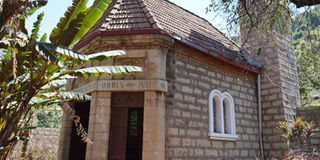Tiny chapel that keeps art, history alive through ages

Mai Mahiu chapel. PHOTO| MACHARIA MWANGI
What you need to know:
Visitors keen on worshipping conduct their own sermon and are free to give offerings. The church is open the whole week, besides hosting the usual Sunday service.
Despite its many years of existence, everything inside its tiny altar is intact, including the tabernacle.
Its tranquillity and historic touch attract even wedding couples, who find it an ideal place to exchange vows that they hope to last as long.
It is a chapel strategically located in a reclusive forested area on the Maai Mahiu-Naivasha highway.
Its simple architecture is a marvel. Built in 1942 by Italian prisoners of war during the Word War II, the house of worship continues to draw faithful due to its location in the foot of the Rift Valley escarpment.
According to records, the chapel was built under the supervision of the British colonialist. Locals call it msikiti (mosque) because of its uncanny resemblance to the Islamic worship house.
Its walls, inscribed in Latin, preserve its history, while its murals are magnificent.
Truck drivers and crew who use the highway find time to worship here, despite their busy schedule.
No mass is celebrated in this 12-seater church, neither is Holy Communion offered. But the tiny church has, perhaps, one of the largest congregations.
Its perimeter fence was recently given a facelift, adding beauty to the church and attracting many a traveller to make stop-overs and catch a glimpse, if not to pray.
Religious long distance travellers find this place a convenient point to stop for a quick supplication, before embarking on the remainder of their journeys.
It is touted as one of the oldest Catholic churches in Kenya that has no permanent members, yet, very popular with faithful from different denominations.
CONDUCT OWN SERMON
Visitors keen on worshipping conduct their own sermon and are free to give offerings. The church is open the whole week, besides hosting the usual Sunday service.
Despite its many years of existence, everything inside its tiny altar is intact, including the tabernacle.
Its tranquillity and historic touch attract even wedding couples, who find it an ideal place to exchange vows that they hope to last as long.
With no resident priest to conduct ceremonies, such couples have to come in with a guest minister.
It is not only worshippers who visit this place. Droves of tourists too frequent the ancient church for photo shoots.
“It can be equated both to a church and a tourist attraction site,” says Mr John Murigu, a former Nakuru County Council chairman. “It is a revered place.”
After the 1980s, they recommended the monument be managed by the National Museums, he adds.





